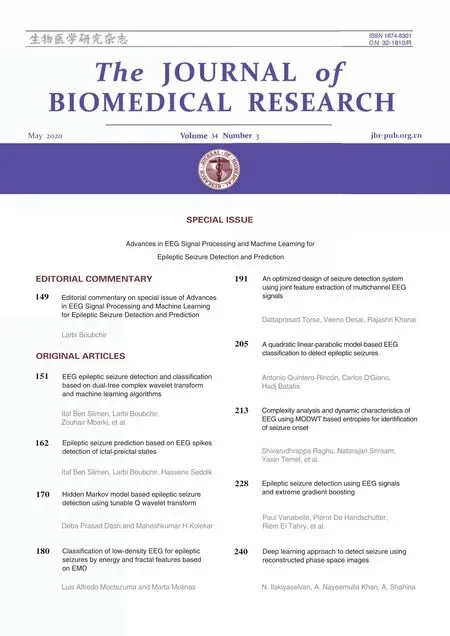Editorial commentary on special issue of Advances in EEG Signal Processing and Machine Learning for Epileptic Seizure Detection and Prediction
2020-01-09LarbiBoubchir
Larbi Boubchir
Laboratoire d'Informatique Avancée de Saint-Denis Research Lab., University of Paris 8, Saint-Denis, Cedex 93526,France.
Abstract This special issue of The Journal of Biomedical Research features novel studies on epileptic seizure detection and prediction based on advanced EEG signal processing and machine learning algorithms. The articles selected present important findings including new experimental results and theoretical studies.
Keywords: epileptic seizure, electroencephalography (EEG), EEG signal processing, machine learning, feature extraction
Epilepsy is the most common neurological disorder of the brain that affects people worldwide from newborn to adult. It is characterized by recurrent seizures, which are brief episodes of signs or symptoms due to abnormal excessive or synchronous neuronal activity in the brain. The electroencephalogram (EEG) is a physiological method to measure and record the electrical activities generated by the brain from electrodes placed on the surface of the scalp. EEG has become the most used signal for detecting and predicting epileptic seizures. Machine learning for EEG signal processing constitute an important area of artificial intelligence dealing with the setting up of automated computer-aided systems allowing to help the medical staff,e.g.neurophysiologists, for detecting and predicting epileptic seizure activities from EEG signals. It offers solutions to difficult biomedical engineering problems related to detecting and predicting EEG epileptic seizures.
The main goal of this special issue is to solicit original contributions with focus on recent advances in EEG signal processing and machine learning for seizures detection and prediction. This special issue selected 9 excellent papers from 20 papers received from a general call. The following paragraphs summarize the published papers.
Ben Slimenet alreported "EEG epileptic seizure detection and classification based on dual-tree complex wavelet transform and machine learning algorithms"[1]. In this paper, the authors propose a robust automatic method for EEG epileptic seizure detection and classification based on Dual-tree complex wavelet transform for feature extraction with supervised learning algorithms.
Ben Slimenet alreported "Epileptic seizure prediction based on EEG spikes detection of ictalpreictal states"[2]. In this study, an epileptic seizure prediction method is proposed based on the EEG spike rate in used as an indicator to anticipate seizure activities in EEG signal.
Dashet alreported "Hidden Markov model based epileptic seizure detection using tunable Q wavelet transform"[3]. This paper presents a method for seizure detection based on entropy features extracted from the different sub-bands of tunable Q wavelet transform with Hidden Markov model.
Moctezumaet alreported "Classification of lowdensity EEG for epileptic seizures by energy and fractal features based on EMD"[4]. In this paper, a novel method for classifying EEG epileptic seizures based on features extracted from Empirical mode decomposition (EMD).
Torseet alreported "An optimized design of seizure detection system using joint feature extraction of multichannel EEG signals"[5]. This paper presents a real time seizure detection system for EEG epileptic seizure detection based on entropy features extracted from Ensemble EMD and TQWT decompositions of EEG signal with supervised learning techniques.
Quintero-Rincónet alreported "A quadratic linearparabolic model-based EEG classification to detect epileptic seizures"[6]. This paper develops an EEG classification method based on a quadratic linearparabolic model and Random forest algorithm to discriminate seizure and non-seizure events.
Raghuet alreported "Complexity analysis and dynamic characteristics of EEG using MODWT based entropies for identification of seizure onset"[7]. In this paper, the complexity analysis and dynamic characteristics of EEG signal based on maximal overlap discrete wavelet transform have been exploited for the identification of seizure onset.
Vanabelleet alreported "Epileptic seizure detection using EEG signals and extreme gradient boosting"[8].In this paper, the problem of automated seizure detection on the Temple University Hospital EEG Seizure Corpus dataset is treated using clinical EEG and machine learning algorithms.
Ilakiyaselvanet alreported "Deep learning approach to detect seizure using reconstructed phase space images"[9]. In this study, the authors propose to use reconstructed phase space images to model the EEG signal as a chaotic system, and use them as input to Convolution Neural Network model.
In conclusion, I trust that readers will find this selection of papers interesting. In addition, I would like to thank all authors contributing to this special issue, and the reviewers for their invaluable comments and recommendations on the submitted papers. Last,but not least, I wish to thank the editorial team for their significant support throughout the process.
杂志排行
THE JOURNAL OF BIOMEDICAL RESEARCH的其它文章
- Deep learning approach to detect seizure using reconstructed phase space images
- Epileptic seizure detection using EEG signals and extreme gradient boosting
- Complexity analysis and dynamic characteristics of EEG using MODWT based entropies for identification of seizure onset
- A quadratic linear-parabolic model-based EEG classification to detect epileptic seizures
- An optimized design of seizure detection system using joint feature extraction of multichannel EEG signals
- Classification of low-density EEG for epileptic seizures by energy and fractal features based on EMD
